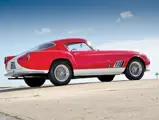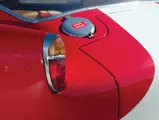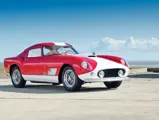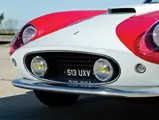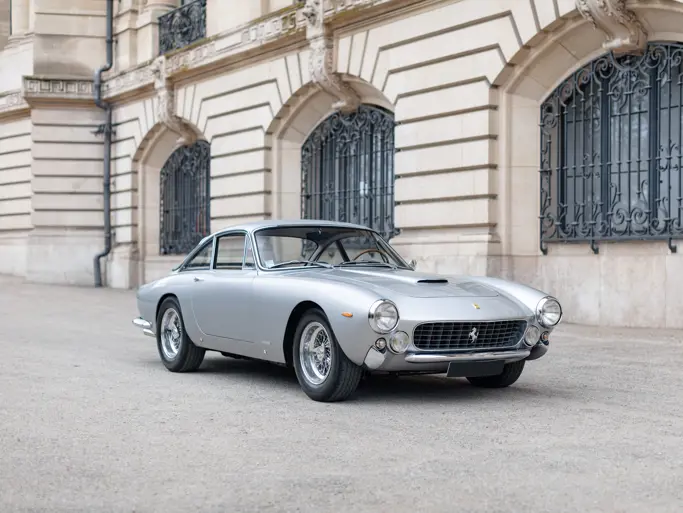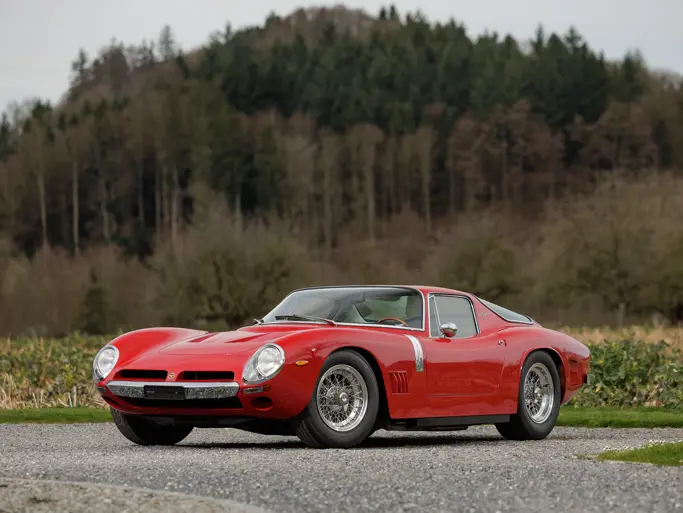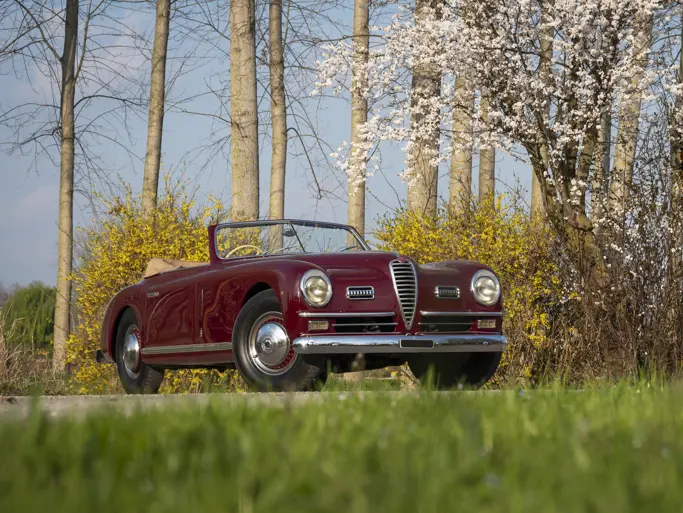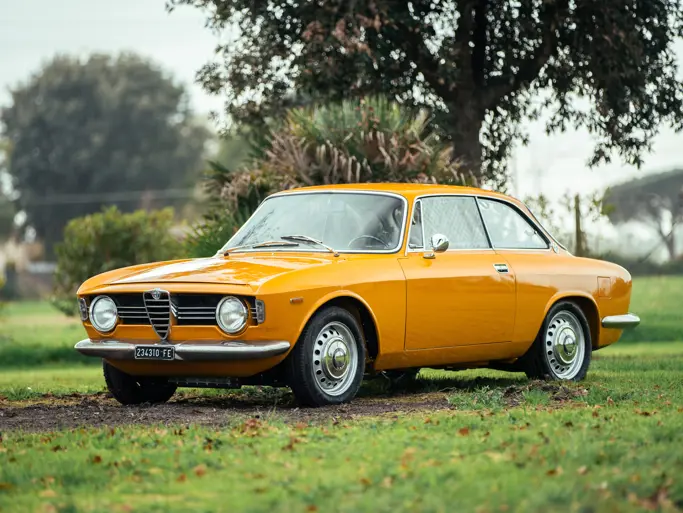London 2011
1958 Ferrari 250 GT LWB 'Tour de France' Berlinetta
{{lr.item.text}}
£2,240,000 GBP | Sold
 | London, United Kingdom
| London, United Kingdom
{{internetCurrentBid}}
{{internetTimeLeft}}

250 bhp at 7,000 rpm, 2,953 cc SOHC alloy block-and-head V-12 engine, triple Weber carburettors, four-speed manual gearbox, independent front suspension with A-arms and coil springs, live rear axle with semi-elliptic leaf springs, and four-wheel hydraulic drum brakes. Wheelbase: 2,600 mm
• One of the most desirable competition-bred Ferraris extant
• Alloy coachwork and V-12 power
• Desirable covered headlamps; one of 36 “single-louver” examples
• Ferrari Classiche-certified and matching numbers
• Restoration by marque specialists in Italy
The Ferrari 250 GT Berlinetta not only has breathtaking looks, it remains arguably the greatest and most important Ferrari road/racing car ever built. Its forerunner was the 250 MM, so-named after the famous Mille Miglia race, which hard-charging Italian hillclimb champion Giovanni Bracco won for Ferrari in 1952. That achievement, plus Ferrari’s first World Driver’s Championship win with Alberto Ascari driving the Type 500 and the company’s first collaboration with Pinin Farina (the 212 Inter cabriolet) combined to make the year 1952 a particularly significant one in the marque’s history.
THE 250 GT LWB BERLINETTA
The last 250 MMs had been built by 1954, and work began on what would become the 250 GT Berlinetta Tour de France. A new strengthened 2,600-mm tubular chassis was equipped with a modern wishbone/coil-spring suspension and the Colombo Tipo 112 “short-block” V-12 engine. Subsequently, this engine was developed further and re-designated Tipo 128B, C and D. Three more 250 GTs similar to the 250 MM followed the prototype Pinin Farina-bodied Berlinetta, 0369 GT, between April and July 1955.
That October, another car was shown at the Paris Salon and was the first design with many side louvers set within the rear sail-panels. Pinin Farina made two more prototypes, one of which was owned by the Marquis de Portago from Spain. At Nassau in December 1955, he scored the first victory for the car, a record that would reach epic proportions by the end of the decade. The Le Mans tragedy of 1955, where Peter Levegh’s Mercedes flew into a crowd of spectators, killing 80 and injuring another 200, prompted the creation of a new Gran Turismo category with an engine capacity of 3.0 litres, which would play directly into Ferrari’s hands in 1956.
Not to be outdone by Pinin Farina, Scaglietti appeared at the 1956 Geneva Motor Show with their own 250 GT prototype, which became known as the limited production, Series I, “14-louvre” 250 GT Berlinetta. The first production car was built in November 1956, and production was now the responsibility of Scaglietti in Modena.
There were five series of 250 GT Berlinettas in all. From mid-1957, the Series II cars were introduced, with three louvers and covered headlights. Just 15 were produced. Series III numbered 36 cars; these retained the covered headlights but had just a single vent louver. In 1959, eight single-louver cars were built with open headlights, a new Italian requirement. Zagato also made five superlight cars.
The real start of the 250 GT Berlinetta’s competition career began in 1956, and the car went on to win more races than either of its legendary successors, the 250 GT SWB and the GTO. Olivier Gendebien won the GT class in the Tour of Sicily at the beginning of 1956, but that year’s Tour de France was 250 GT Berlinetta’s most important race and propelled the car into the annals of motorsport history.
The Tour de France took five or six days and covered almost 5,000 gruelling kilometres around France, sometimes venturing into Italy, Belgium or Germany. The race consisted of up to six circuit races, two hillclimbs and a sprint. In 1956, in de Portago’s first attempt, with Edmund Nelson as co-driver in his Ferrari, he took the victory with Stirling Moss in a Mercedes 300SL second and Gendebien third in the first Pinin Farina ex-works development car, 0357 GT. With this win, ‘Fon’ de Portago earned the Ferrari 250 GT Berlinetta its enduring sobriquet, the Tour de France. In the hands of Olivier Gendebien, the 250 GT Tour de France was victorious for the next three straight years in the race whose name the car had now unofficially taken, and the car and its enviable competition record remain the stuff of legends today.
CHASSIS 1039 GT
The example offered here, 1039 GT, was supplied new via US Ferrari Importer Luigi Chinetti Motors of Greenwich, Connecticut to its first owner Hastings Harcourt of Santa Barbara, California on 26 November, 1958. Mr. Harcourt was the heir and owner of Harcourt Brace, the well known book publisher. Of particular note, 1039 GT is one of the 39 competition 250 GT LWB Berlinettas originally produced by Ferrari with all-alloy bodywork, the single vent and the desirable covered-headlamp configuration.
1039 GT remained in America for most of its life, and during this phase, it changed hands amongst a number of American collectors, as documented by Ferrari historian Marcel Massini. Early in its life in the United States, Ford units replaced the original engine and gearbox. The original 250 series V-12 engine was later reunited with the TdF, as confirmed by the Ferrari Classiche certification. In 1974, Charles W. Betz and Fred Peters of Orange, California acquired 1039 GT and re-united the TdF with its original Ferrari 250 series V-12 engine and gearbox.
The rare Ferrari remained in America for many years thereafter and was successfully campaigned a number of times at the world-famous Monterey Historic Automobile Races in Laguna Seca during the 1980s. In the early 1990s, 1039 GT was sold to Switzerland, and there, it joined an important Swiss-based private automobile collection. The prominent owner used the car sparingly in Switzerland and abroad, when it was driven on the Tour Auto in 1997 and in 1999. He retained 1039 GT for many years, and in 2005, it was certified by the Ferrari Classiche program, which confirms that the car retains its engine and all of its main components the way it was built by the factory, and therefore, it is indeed a true matching-numbers example.
The car was restored in Italy by some of the finest recognised Ferrari specialists in the Modena area, the birthplace of Ferrari. The engine was entrusted to Diena, who performed a full rebuild, Bacchelli & Villa handled the coachwork, and the interior was entrusted to the respected Selleria Luppi. Upon completion of the restoration, the car was tested and featured in Octane in January 2006, marking a thoroughly enjoyable and particularly satisfying drive for the magazine’s testers.
From Switzerland, the car was sold to its next and current English owner in late 2005, who is himself a fastidious collector. Upon acquisition of the car, he enrolled and was accepted to participate in that year’s edition of the Mille Miglia. Demanding perfection of all of the cars within his collection, the current owner recently commissioned UK-based Ferrari specialists GTO Engineering to perform a full, no-expense-spared service on 1039 GT at a cost of over GBP 10,000. Any mechanical part that was at all worn was changed, and as offered now, the 1039 GT runs beautifully and stands ready to be enjoyed. Of course, with its legendary pedigree, it will surely be welcomed at most any event the new owner chooses to enter.
RM Auctions has recently inspected the car, and we can confirm that 1039 GT presents very well. Some of the world’s premier Ferrari experts carried out its restoration, and it still shows today. The bodywork is straight, and the doors display proper fit. The paintwork is near-perfect, and the correctly trimmed tan leather upholstery presents beautifully, a true mark of Luppi’s workmanship, with the crackle-finished dash giving 1039 GT a true competition feel when you slip behind the wheel. The outside fuel filler, covered headlamps and single louver give the car an undeniable competition-bred presence, and as offered today, 1039 GT is correct in every way—a fact confirmed not only by marque specialists but also by the all-important Ferrari Classiche certification binder that accompanies it. Truly rare, purposefully beautiful and capable of performance that remains very impressive even today, this 250 GT Tour de France Berlinetta is steeped in Ferrari’s rich competition legacy and very capably represents one of the most highly coveted Ferrari models ever built.







